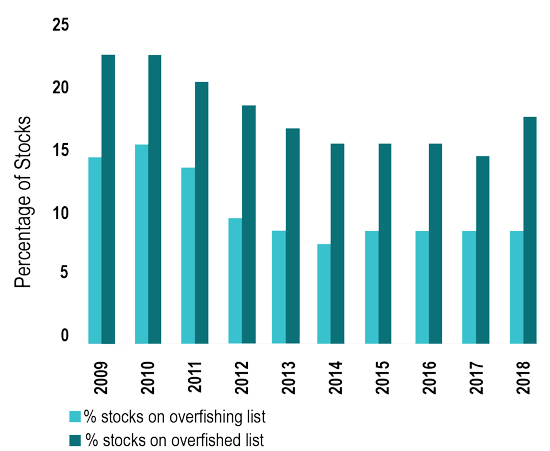Number of Fish Stocks at Sustainable Level Remains High
by Fishermen’s Voice Staff
Fishermen harvest
mackerel in large
volumes using
mid-water trawls.
The number of U.S. fish stocks subject to overfishing remains at a near all-time low, according to the 2018 Status of U.S. Fisheries Annual Report.
The latest report was submitted by the National Oceanic and Atmospheric Administration (NOAA) to Congress in August.
The report details the status of 479 managed stocks or stock complexes in the U.S. to identify which stocks are subject to overfishing, are overfished, or are rebuilt to sustainable levels.
In the Gulf of Maine, Atlantic mackerel was added to the overfishing/overfished list for the first time.
In 2016, commercial landings of Atlantic mackerel totaled 11.7 million pounds and were valued at more than $3 million.
Commercial landings from 2004 to 2016 ranged from a high of 125 million pounds in 2006 to a low of 1.1 million pounds in 2011.
The U.S. commercial fishery for Atlantic mackerel operates between May and December in the Gulf of Maine and between January and May in southern New England and Mid-Atlantic coastal waters. Fishermen harvest mackerel in large volumes using mid-water trawls.
Mackerel are also important to recreational fisheries in New England and the Mid-Atlantic, with the highest landings occurring from Maine to Massachusetts. In 2016, recreational harvest of Atlantic mackerel totaled 3 million pounds, most of which was caught in Massachusetts, New Hampshire and Maine.
After nine years in a rebuilding plan with strict management, including a prohibition on landings, Gulf of Maine smooth skate was declared rebuilt in 2018.
The vast majority
of U.S. fish stocks
were at sustainable
population levels
in 2018.
For New England, overfishing and overfished stocks include Gulf of Maine cod, Georges Bank cod, Gulf of Maine/Georges Bank windowpane, witch flounder, Cape Cod/Gulf of Maine yellowtail flounder, Georges Bank yellowtail flounder, Southern New England/Mid-Atlantic yellowtail flounder, Gulf of Maine thorny skate, Atlantic halibut, Atlantic salmon, Atlantic wolfish, ocean pout, Southern New England/Mid-Atlantic winter flounder, Southern Georges Bank/Mid-Atlantic red hake, and Gulf of Maine/Cape Hatteras Atlantic mackerel.
Building on trends of the past few years, the report said the vast majority of U.S. fish stocks were at sustainable population levels in 2018, and the number of U.S. fish stocks subject to overfishing remains at a near all-time low, according to a press release.
The report also documents a newly-rebuilt stock, smooth skate in the Gulf of Maine. This brings the total number of rebuilt U.S. marine fish stocks to 45 since the year 2000.

NOAA Graphic
In 2016, U.S. commercial fishing, recreational fishing, and the seafood industry generated $212 billion in sales, contributed $100 billion to the gross domestic product, and supported 1.7 million full- and part-time jobs.
A stock is on the “overfishing” list when the harvest rate of that species is too high. Of 321 stocks with known status, 293 (91%) are not subject to overfishing. The remaining 28 stocks (9%) are subject to overfishing. Seven stocks were removed from the overfishing list, and five were added in 2018.
As required under the Magnuson-Stevens Act, NOAA’s National Marine Fisheries Service (NMFS) works with regional fishery management councils and other partners to implement measures to immediately end overfishing.
A stock is on the “overfished” list when the population size of a stock is too low, whether because of fishing or other causes, such as environmental changes. Of 244 stocks with known status, 201 (or 82%) are not overfished, leaving 43 stocks (18%) listed as overfished. No stocks were removed from the overfished list in 2018, but eight were added. Several of these stocks are impacted by factors outside the control of domestic fisheries management. For example, for three stocks of coho salmon in Washington state, warmer water, drought or habitat degradation contributed to less than ideal spawning conditions.
One stock has been declared rebuilt: Smooth skate in the Gulf of Maine, which had been in a rebuilding plan for nine years under strict management.
As a harvest rate, “overfishing” is a direct result of fishing activities. Allowed to continue unchecked, overfishing is associated with negative outcomes, including a depleted population. Current management practices—such as annual catch limits and accountability measures—reduce the likelihood of this happening.
Environmental change,
habitat degradation,
and international
fishing contributed
to the status of
the eight new
overfished stocks.
As a population size, “overfished” can be the result of many factors, including overfishing, as well as habitat degradation, pollution, climate change, and disease. While overfishing is sometimes the main cause of an overfished stock, these other factors can also play a role and may affect the stock’s ability to rebuild.
The eight stocks added to the 2018 overfished list illustrate numerous challenges inherent in fisheries management. Environmental change, habitat degradation, and international fishing contributed to the status of the eight new overfished stocks. For example, relatively warm water conditions may be impacting the growth and reproduction of the cold-water Saint Matthew Island blue king crab. This stock has never been subject to overfishing and directed fishing for this crab has been prohibited since 2016. Warm ocean conditions, including the warm “Blob” in the northeast Pacific Ocean, reduced the number of spawning coho salmon returning to their natal rivers, and both Chinook and coho salmon have been impacted by habitat degradation caused by drought and lack of sufficient water for spawning. During the past five years, several of the fisheries for these salmon stocks have been declared fishery disasters under the MSA by the Secretary of Commerce due to factors beyond the control of fishery managers.
Some of the overfished stocks are also impacted by international harvest that the United States has limited ability to control. For example, the United States accounts for only 1 percent of the total international landings of Atlantic bigeye tuna. Additionally, salmon stocks are impacted by inland fisheries; federally managed ocean harvest of the three overfished coho salmon stocks accounts for less than 25 percent of the total fishing mortality.
